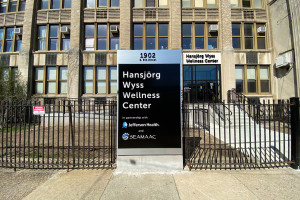Philly Has the Worst Tech Economy of All Amazon HQ2 Finalists, Says Washington Post
A new index rates each city on metrics like new business creation and quality of life. Here’s why the City of Brotherly Love landed at the bottom but why the ranking isn’t a stamp of doom.

Philadelphia skyline.
This month, the Washington Post published its magnum opus on Amazon’s HQ2 competition. The publication created a thorough index to determine how the 20 finalists stack up on the strength of the tech economies they’ve already built. Though the report says each of the cities will continue to grow whether Amazon makes its home there, Philadelphia landed on the bottom of the index along with Miami.
The Washington Post analyzed Philadelphia’s assets according to nine key metrics using information from Brookings and other analysts. Here are the highlights:
Workforce
1. Philly lands in the middle for its number of high-skilled workers.
This metric based on 2015 data measures jobs in high-value, high-paying industries (think: programmers, accountants, architects, managers and consultants) that are mostly accessible to people with four-year degrees. DC scored best, and Miami scored the worst.
2. On patents, Philly does better than most of the other cities.
According to Post, a region’s patent filings are tangible indicators of new ideas. Only three cities—Boston, Raleigh and Austin rank above Philadelphia. It’s clear efforts by local institutions like Penn have something to do with Philly’s standing
3. On new business creation, Philly is behind.
According to information from the U.S. Census Bureau, Philly sits lower than most of the other Amazon HQ2 competitors for how well it can start and grow companies. Just Indiana, Los Angeles and Pittsburgh ranked worse.
4. Philly is near the bottom on digital services growth.
The City of Brotherly Love isn’t producing digital services companies at the rate of the other cities. Philly is at the bottom of this index along with DC and Columbus, Ohio.
New Talent
5. Philly fares well for its number of young people in college.
This is no surprise. Yet, while the Philadelphia region boasts 102 colleges and universities, it was still bested by Boston (and also Austin, Los Angeles, New York and Raleigh) on this metric, which looks at the number of local 18-to-24-year-olds enrolled in college.
6. Philly is average for its number of jobs in STEM occupations.
This measure assessed the number of jobs in STEM occupations. Raleigh and DC lead the pack. Philly sits in the middle with cities like Pittsburgh and Dallas.
Cost of Living and Quality of Life
7. Philly is near the bottom when it comes to income spent on housing and transportation.
Though Philly has most cities beat on affordability alone, this metric measured how expensive cities are to live in compared with how much money people are making. DC and Boston (the top two on this metric) are among the priciest places to find a home, but there are more transportation options, so some residents can afford to not own cars, and people make more money, the report says.
8. Philly is not very attractive to workers.
When it comes to weather, food, crime and cultural institutions, workers would rather be in cities like Los Angeles, Denver and Miami, which measured the best for their amenities and assets. Philly is at the bottom with Indianapolis, Pittsburgh and Dallas.
9. Pennsylvania’s credit rating brings Philly down.
This final assessment evaluates state bond ratings. Chicago, Philly and Pittsburgh were the only cities on the list with a “mid” rating. All other cities rated “high.”
The Washington Post combined all of these factors to create the overall index that puts Austin, Boston and Raleigh at the top and Columbus, Philadelphia and Miami at the bottom. Though Philly ranked low on many metrics, the report says the cities at the bottom, or “the laggers,” are “poised for growth.”
“The cities near the bottom of the index are already outperforming the rest of the country and are likely to enjoy future growth because of it,” the report authors wrote.
Brookings Institution fellow Joseph Parilla told the Post that his biggest takeaway is that “there are more mid-sized places that are really emerging in this space.” This means that Amazon and other tech firms will come back to this list, and not for the subsidies, the report states.


